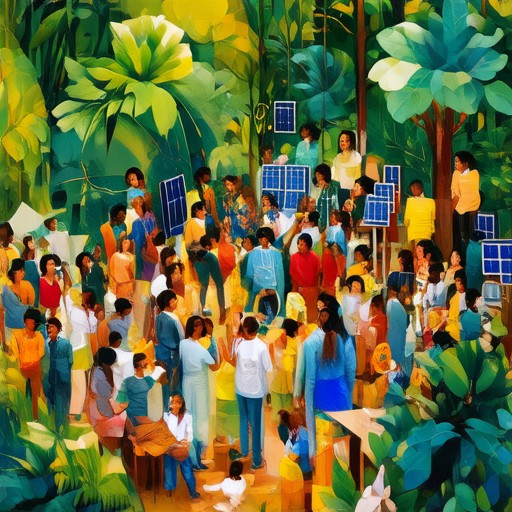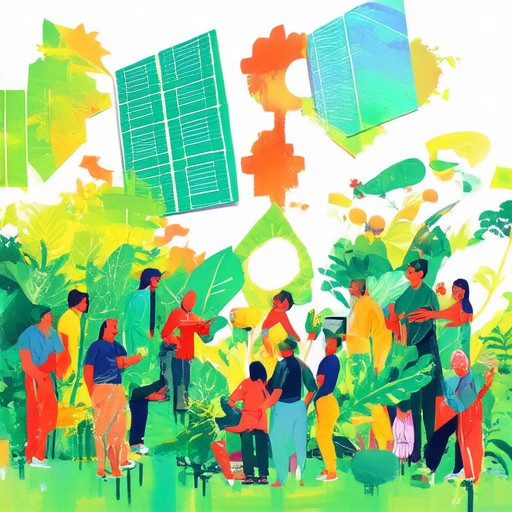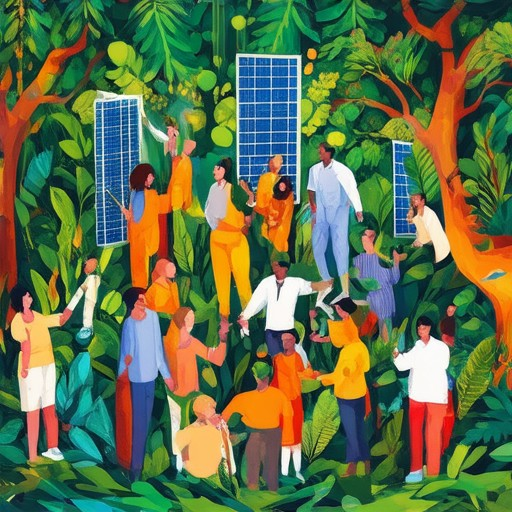Are you looking for innovative ways to foster sustainability and bring your community closer together? Green community projects offer a unique opportunity to create meaningful change while promoting environmental health and social cohesion. Whether you’re a resident, a local leader, or a student exploring creative solutions, these initiatives can transform neighborhoods into vibrant, eco-conscious hubs. From urban gardening to renewable energy installations, green community projects encompass a wide range of activities designed to benefit both people and the planet. In this article, we’ll explore what green community projects entail, share real-world examples, and provide actionable ideas to inspire your own sustainable endeavors. By working together, we can build resilient communities that prioritize sustainability and inclusivity, ensuring a brighter future for generations to come.

What Is a Green Community?
A green community is an intentional neighborhood or settlement that prioritizes environmental sustainability, ecological harmony, and social equity. These communities often adopt sustainable practices to minimize their environmental footprint while fostering a strong sense of community and shared responsibility.
Examples of Green Communities
- Dancing Rabbit Ecovillage
Located in Rutledge, Missouri, Dancing Rabbit is a well-known example of a green community established in 1997. With a population of about 30 residents, it focuses on sustainable living through cooperative governance and eco-friendly practices. Residents actively participate in organic farming, renewable energy use, and resource conservation. - EcoVillages International Network
The EcoVillages International Network includes various sustainable settlements worldwide, such as the Findhorn Community in Scotland. These villages emphasize permaculture, renewable energy, and communal living, serving as models for sustainable development. - Transition Towns
Transition Towns is a global network of communities working towards peak oil preparedness and climate change mitigation. These towns focus on local food production, energy efficiency, and community-based initiatives to foster resilience and sustainability. - Co-housing Communities
Co-housing communities, such as those managed by the Cohousing Network, promote shared resources and collaborative living spaces. These neighborhoods often feature energy-efficient buildings, shared amenities, and a strong emphasis on community engagement. - Sustainable Neighborhoods
Many urban neighborhoods are transforming into sustainable models. For instance, the Notting Hill neighborhood in London has implemented green infrastructure, renewable energy projects, and community gardens to enhance sustainability.
Each of these examples demonstrates how green communities can vary in size, structure, and approach, but they all share a common goal of creating healthier, more harmonious living environments for future generations.
What is a Green Project Example?
A green project example refers to any initiative or program focused on environmental sustainability, social responsibility, or economic development through sustainable practices. These projects aim to address global challenges like climate change, resource depletion, and inequality while delivering measurable benefits to society and the planet.
Here are some notable examples of green projects:
- Renewable Energy Initiatives : Projects like wind farms and solar energy farms are prime examples of green initiatives. These projects not only reduce carbon emissions but also create jobs and provide clean energy to communities.
- Sustainable Agriculture : Programs promoting organic farming, afforestation, and soil conservation are excellent green projects. They enhance biodiversity, improve water retention, and promote food security.
- Public Transportation Expansion : Initiatives like public transit systems, bike-sharing programs, and electric vehicle promotions encourage low-carbon mobility, reducing urban pollution and traffic congestion.
- Waste Management Solutions : Green projects focused on recycling, composting, and waste-to-energy plants help reduce landfill waste and minimize environmental harm.
- Community Empowerment : Microgreen projects and local gardening initiatives empower individuals to grow their own food sustainably, fostering a connection to nature and promoting self-sufficiency.
These examples demonstrate how green projects can have a transformative impact on ecosystems, economies, and communities. By prioritizing sustainability, they contribute to a healthier planet for future generations.

What Are Greening Projects?
Greening projects refer to initiatives aimed at integrating natural elements into urban environments to enhance sustainability, biodiversity, and overall quality of life. These projects often involve the creation or restoration of green spaces, such as parks, gardens, rooftops, and streetscapes, to promote ecological balance and mitigate the effects of urbanization.
Types of Greening Projects
- Rooftop Gardens : These are installed on rooftops to provide green cover, reduce urban heat island effects, and offer recreational spaces.
- Street Trees : Planting trees along streets enhances air quality, reduces runoff, and adds aesthetic value to neighborhoods.
- Rainwater Harvesting Systems : These systems collect and store rainwater for reuse, reducing the demand on municipal water supplies.
- Green Walls : Vertical gardens installed on building facades to create green spaces without sacrificing usable space.
- Community Gardens : Shared spaces where residents can grow their own plants, fostering a sense of community and providing fresh produce.
Benefits of Greening Projects
- Environmental Benefits : Greening projects help reduce air pollution, improve water quality, and combat climate change by sequestering carbon dioxide.
- Social Benefits : They foster community engagement, provide mental health benefits through exposure to nature, and create opportunities for education and skill development.
- Economic Benefits : Green spaces can increase property values, attract businesses, and reduce healthcare costs associated with poor air quality.
Prominent Greening Projects
Some well-known examples include:- New York High Line : An elevated park built on an abandoned rail line, showcasing the potential of repurposing industrial spaces.- Singapore’s Supertree Grove : A futuristic garden featuring tall trees enclosed in glass domes to showcase biodiversity.- Paris’ Jardin des Dames : A historic garden transformed into a sustainable urban landscape with native plants and innovative irrigation.
Why Support Greening Projects?
Supporting these initiatives helps create healthier, more resilient communities. By participating in or advocating for greening projects, individuals contribute to a better quality of life while promoting environmental stewardship.
To learn more about how you can get involved, visit our green living guide .

Green Activities: A Comprehensive Guide
Eco Planeta Verde encourages everyone to take small yet impactful steps toward sustainability. Here are some green activities you can incorporate into your daily life:
- Reduce Food Waste: Plan meals carefully to minimize waste. Consider shopping locally or joining a CSA (Community Supported Agriculture) to reduce packaging.
- Conserve Water: Install water-saving fixtures and rain barrels. Avoid excessive watering for lawns and gardens, focusing on native plants instead.
- Support Local Businesses: Shop at farmers’ markets or local businesses to reduce transportation emissions and promote sustainable economies.
- Compost: Turn kitchen scraps and yard waste into nutrient-rich compost, benefiting your garden and reducing landfill waste.
- Plant Trees: Participate in tree-planting initiatives or start your own tree nursery. Trees absorb CO2 and provide habitats for wildlife.
- Use Renewable Energy: Invest in solar panels or switch to a green energy provider to reduce reliance on fossil fuels.
- Reduce Plastic Use: Opt for reusable containers, cloth bags, and other eco-friendly alternatives to cut down on plastic consumption.
- Support Wildlife: Create bird feeders or wildlife habitats in your backyard, providing shelter and food for local animals.
- Cycle or Walk: Choose public transport, cycling, or walking over driving to reduce carbon emissions and stay healthy.
Eco Planeta Verde advocates for a holistic approach to sustainability, encouraging individuals to adopt these practices consistently. By making small changes today, we can create a healthier planet for future generations.
For more tips and resources, visit our sustainable living guide . Let’s work together to make every day a greener day!
What Are 10 Examples of Green?
- Solar Panels: Devices that convert sunlight directly into electricity, reducing reliance on fossil fuels.
- Wind Turbines: Structures that harness wind energy to generate electricity, contributing to renewable energy sources.
- Electric Vehicles: Cars and buses powered entirely by electricity, reducing greenhouse gas emissions.
- Composting: Process of breaking down organic waste into nutrient-rich soil, reducing landfill use and promoting sustainability.
- Recycling Programs: Initiatives that collect and process materials to reduce waste and promote resource reuse.
- Green Buildings: Structures designed to minimize environmental impact through energy efficiency and sustainable materials.
- Energy-Efficient Appliances: Devices that consume less energy, lowering utility costs and reducing carbon footprints.
- Public Transportation Systems: Services that reduce individual car usage, decreasing air pollution and traffic congestion.
- Sustainable Agriculture: Practices like organic farming and crop rotation that preserve biodiversity and soil health.
- Eco-Friendly Products: Items made from recycled materials or processes that minimize environmental harm.

What is Considered a Green Project?
A green project is any initiative or endeavor focused on promoting sustainability, environmental conservation, and eco-friendly practices. These projects aim to minimize environmental impact while delivering benefits to society and future generations.
Types of Green Projects
Green projects can be categorized into several types based on their focus and application:
1. Urban Development
- Green infrastructure projects, such as parks, gardens, and public spaces designed to enhance biodiversity and improve air quality.
- Sustainable building practices, including the use of recycled materials and energy-efficient designs, often certified by programs like LEED (Leadership in Energy and Environmental Design).
2. Energy Efficiency
- Installation of renewable energy systems, such as solar panels or wind turbines, to reduce reliance on non-renewable energy sources.
- Upgrading buildings to improve energy efficiency, including better insulation and the use of energy-efficient appliances.
3. Water Conservation
- Implementation of water-saving technologies, such as rainwater harvesting systems and greywater recycling.
- Initiatives to protect and restore waterways, ensuring sustainable water resource management.
4. Community Engagement
- Local clean-up drives and tree-planting events aimed at improving environmental quality in neighborhoods.
- Educational campaigns and workshops to raise awareness about environmental issues and sustainable living practices.
Importance and Impact of Green Projects
Green projects play a vital role in addressing global challenges such as climate change, biodiversity loss, and resource depletion. They contribute to:
- Climate Change Mitigation : By reducing carbon emissions and promoting renewable energy use.
- Biodiversity Preservation : Creating habitats for wildlife and supporting ecosystem health.
- Sustainable Development : Promoting practices that ensure long-term environmental, economic, and social benefits.
These projects often align with broader sustainability goals, such as those outlined in the United Nations’ Sustainable Development Goals (SDGs).
Conclusion
Eco Planeta Verde is at the forefront of promoting green projects through its comprehensive platform. By offering resources, tips, and inspiration, Eco Planeta Verde empowers individuals and communities to adopt sustainable practices. Their platform serves as a hub for discovering and participating in green initiatives, contributing to a healthier planet for future generations.




0 Comments